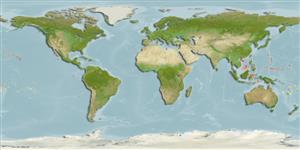Environment: milieu / climate zone / depth range / distribution range
Ekologi
marina djupbottenlevande; djupintervall 280 - 363 m (Ref. 13707). Deep-water
Pacific Ocean: western Indonesia and the Hawaiian Islands.
Size / Vikt / Age
Maturity: Lm ? range ? - ? cm
Max length : 9.8 cm SL hane/ej könsbestämd; (Ref. 13707)
Taggstrålar i ryggfenan (totalt) : 3; Mjukstrålar i ryggfenan (totalt) : 13 - 15; Mjukstrålar i analfenan: 13 - 14. Female first spine of first dorsal fin shorter than second spine. Male first spine of first dorsal fin bearing a filament. Upper third of caudal fin with a dark streak (Ref 42912).
Benthic on sand (Ref. 58302).
Life cycle and mating behavior
Maturities | Reproduktion | Spawnings | Egg(s) | Fecundities | Larver
Fricke, R., 1992. Revision of the family Draconettidae (Teleostei), with descriptions of two new species and a new subspecies. J. Nat. Hist. 26(1):165-195. (Ref. 13707)
IUCN Red List Status (Ref. 130435)
Threat to humans
Harmless
Human uses
Verktyg
Special reports
Download XML
Internet-källor
Estimates based on models
Preferred temperature (Ref.
123201): 3.7 - 3.7, mean 3.7 °C (based on 1 cells).
Phylogenetic diversity index (Ref.
82804): PD
50 = 0.5001 [Uniqueness, from 0.5 = low to 2.0 = high].
Bayesian length-weight: a=0.00389 (0.00180 - 0.00842), b=3.12 (2.94 - 3.30), in cm total length, based on all LWR estimates for this body shape (Ref.
93245).
Trofisk nivå (Ref.
69278): 3.3 ±0.4 se; based on size and trophs of closest relatives
Fishing Vulnerability (Ref.
59153): Low vulnerability (10 of 100).
